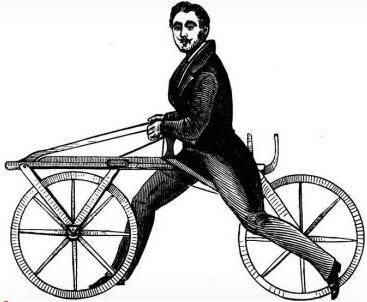The bicycle was introduced in the 19th century in Europe by German Inventor Karl von Drais. He is credited with developing the first bicycle. He introduced it to the people in Paris in 1818. It is supposed to originate from the human-powered vehicle called Draisines. Drais invented a walking machine that would help him get around the royal gardens faster. It was known by many names, including the “velocipede,” “dandy horse,” “hobby-horse,” “draisine” and “running machine. It had no pedals and its frame was a wooden beam. It had two same-size in-line wheels with the front one steerable and mounted in a frame which was straddled.
 In 1839, Kirkpatrick MacMillan, a Scottish blacksmith, allegedly completed construction of a pedal driven bicycle of wood that included iron-rimmed wooden wheels. It had a steerable wheel in the front and a larger wheel in the rear. The bicycle had a mechanical crank drive to drive the vehicle. Thus, the modern bicycle came into being. This first pedal bicycle was propelled by a horizontal reciprocating movement of the rider’s feet on the pedals. This movement was transmitted to cranks on the rear wheel by connecting rods. The bicycle was extremely heavy and the physical effort required to ride it was considerable.
In 1839, Kirkpatrick MacMillan, a Scottish blacksmith, allegedly completed construction of a pedal driven bicycle of wood that included iron-rimmed wooden wheels. It had a steerable wheel in the front and a larger wheel in the rear. The bicycle had a mechanical crank drive to drive the vehicle. Thus, the modern bicycle came into being. This first pedal bicycle was propelled by a horizontal reciprocating movement of the rider’s feet on the pedals. This movement was transmitted to cranks on the rear wheel by connecting rods. The bicycle was extremely heavy and the physical effort required to ride it was considerable.
In 1860, French inventors Pierre Michaux and Pierre Lallement designed the first true bicycle. It had a high-seated and big front-wheeled bicycle – formally called an Ordinary or high-wheel bicycle. It had issues due to its bad weight distribution. In 1861 a crank and pedals were added but not brakes which resulted in many dangerous “headers.” In 1878, the dwarf ordinary bicycle mended these faults but the front oversized wheel remained a problem. On July 20, 1865, Pierre Lallement arrived in the United States, carrying the plans and components for this first modern bicycle.
 In 1870 the Penny Farthing bicycle was invented. The name came from the idea that the wheels resembled two coins, the penny and the farthing next to each other, the former significantly larger than the latter. It was unstable, extremely difficult to get on and off and the front wheel was used for power and steering. Considering, it was not an ideal or efficient machine
In 1870 the Penny Farthing bicycle was invented. The name came from the idea that the wheels resembled two coins, the penny and the farthing next to each other, the former significantly larger than the latter. It was unstable, extremely difficult to get on and off and the front wheel was used for power and steering. Considering, it was not an ideal or efficient machine
In 1885 a bicycle named the Rover was invented by John Kemp Starley was characterized by two wheels of the same size and a rear wheel connected and driven by a chain. This made for a more efficient bicycle with smaller wheels. This bicycle was safer than the penny-farthing because of the lower center of gravity. Starley’s Rover was the first modern bicycle in its true sense with even wheels and a proper seat.
New developments in brakes and tires followed shortly after and established a basic template for what would become the modern bicycle.
When the modern bicycle was developed in the late 1800’s, most frames were made with steel tubing instead of wood or cast iron. While the steel bicycles were strong they were also very heavy. It was not uncommon for a bicycle of that era to weigh in at over 80 pounds.
Interest in the two-wheeled machines exploded and by the 1890’s Europe and the United States were in the midst of a bike craze. A New York Times article from 1896 gushed that “the bicycle promises a splendid extension of personal power and freedom, scarcely inferior to what wings would give.”
